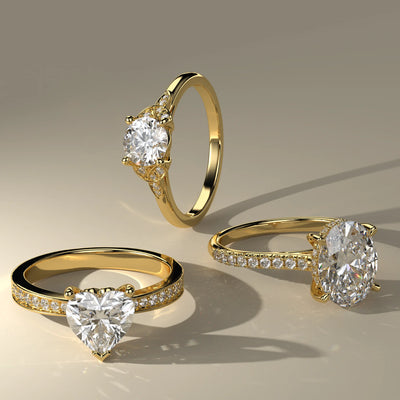Understanding Diamond Anatomy: A Complete Guide for Informed Choices
When you look at a diamond, you're not just admiring its sparkle; you're witnessing a masterpiece of precise craftsmanship and natural geometry. Every part of a diamond plays a crucial role in how it reflects light, shines, and ultimately captures your heart. Understanding the anatomy of a diamond isn't just for gemologists, it's for anyone who wants to make an informed choice when investing in this timeless gem.
Let’s break down the key parts of a diamond, so you can understand what each component contributes to its brilliance and beauty.
| Diamond Feature | Details |
|---|---|
| 1. Table |
The table is the flat, topmost surface of the diamond and is the largest facet. It serves as the main entry and exit point for light, playing a significant role in how much brilliance and fire the diamond exhibits. Why It Matters: A well-proportioned table ensures optimal light reflection. If the table is too large, the diamond may lose sparkle. If too small, it may appear dark. Expert Tip: Look for a diamond with an ideal table percentage (usually 52%-62% of the diamond's diameter) for maximum light performance. |
| 2. Crown |
The crown is the upper portion of the diamond, sitting just below the table and above the girdle. It consists of several facets, including star, bezel, and upper girdle facets. Why It Matters: The crown acts like a prism, breaking light into dazzling flashes of color. The angle of the crown affects how light interacts within the stone. Expert Tip: Ideal crown angles typically fall between 34-36 degrees for maximum brilliance. |
| 3. Girdle |
The girdle is the thin perimeter or outer edge of the diamond, separating the crown from the pavilion. It can be faceted, polished, or unpolished. Why It Matters: A well-proportioned girdle ensures structural integrity. If too thin, the diamond may be prone to chipping; if too thick, it may appear bulky. Expert Tip: Look for a girdle that is classified as "Thin" to "Slightly Thick" for a balanced appearance. |
| 4. Diameter |
The diameter is the width of the diamond when viewed from the top, measured edge to edge across the girdle. Why It Matters: It determines the overall spread and appearance of the diamond. A well-cut diamond balances diameter with depth for optimal light reflection. Expert Tip: When comparing diamonds of the same carat weight, a larger diameter often means better visual size. |
| 5. Pavilion |
The pavilion is the lower portion of the diamond, located beneath the girdle and ending at the culet. Its main role is to reflect light back through the crown. Why It Matters: A well-cut pavilion maximizes light return. If too shallow or too deep, light will leak out from the sides or bottom, reducing brilliance. Expert Tip: Look for symmetry and consistent pavilion angles to ensure maximum light performance. |
| 6. Lower Girdle/Half Facet Length |
The lower girdle facets extend from the girdle towards the culet and play a subtle but important role in light dispersion. Why It Matters: Longer lower girdle facets create sharper, more defined sparkles. Shorter lower girdle facets produce broader flashes of light. Expert Tip: Ideally, lower girdle facet length should be between 75-80% of the pavilion depth. |
| 7. Culet |
The culet is the tiny facet (or sometimes a point) at the very bottom of the diamond's pavilion. Why It Matters: A large culet can appear as a dark spot when viewed from the top. A small or non-existent culet helps maintain a clean, uninterrupted look. Expert Tip: Opt for diamonds with a "None" or "Very Small" culet grade for a flawless finish. |
| 8. Total Depth |
The total depth refers to the measurement from the table to the culet, expressed as a percentage of the diamond's diameter. Why It Matters: Depth directly impacts how light travels through the diamond. A depth that is too shallow or too deep can cause light to leak, reducing brilliance. Expert Tip: Ideal total depth percentages vary slightly depending on the diamond shape, but for round diamonds, aim for 59%-62%. |
Conclusion: Bringing It All Together
Every component of a diamond works together to create the breathtaking sparkle we all adore. Whether you're selecting a diamond for an engagement ring, a special gift, or an investment, understanding these details will empower you to make a confident choice.
A diamond isn't just a stone, it's a symphony of precision, science, and artistry. Now, with this knowledge, you're not just buying a diamond; you're appreciating its every facet.
- Choosing a selection results in a full page refresh.


